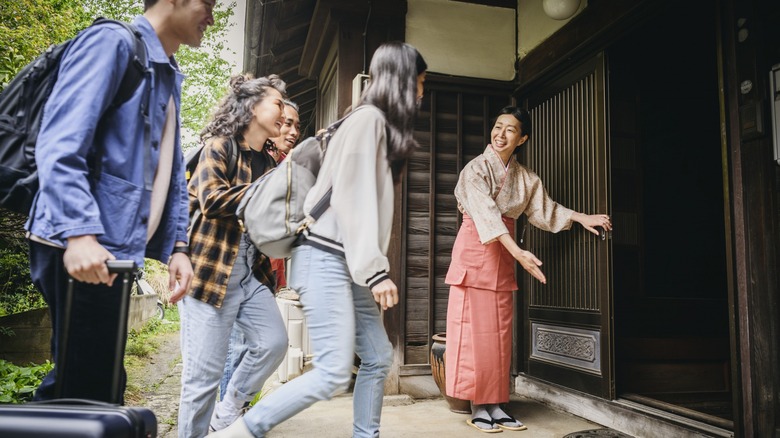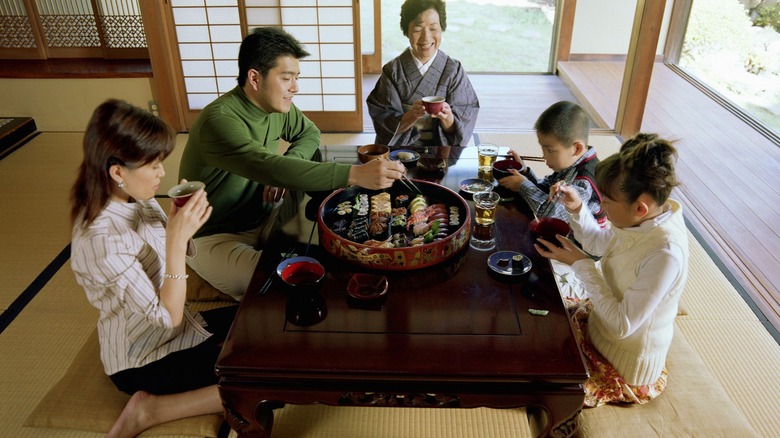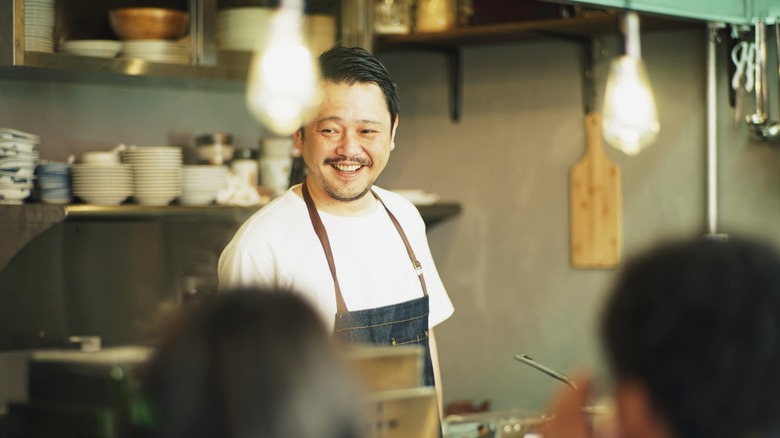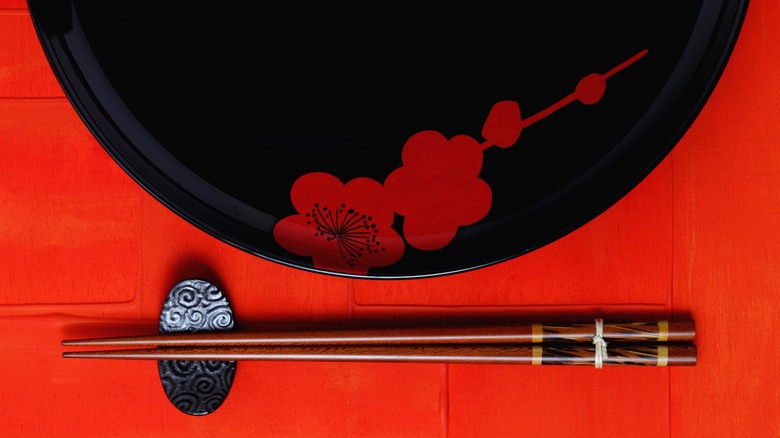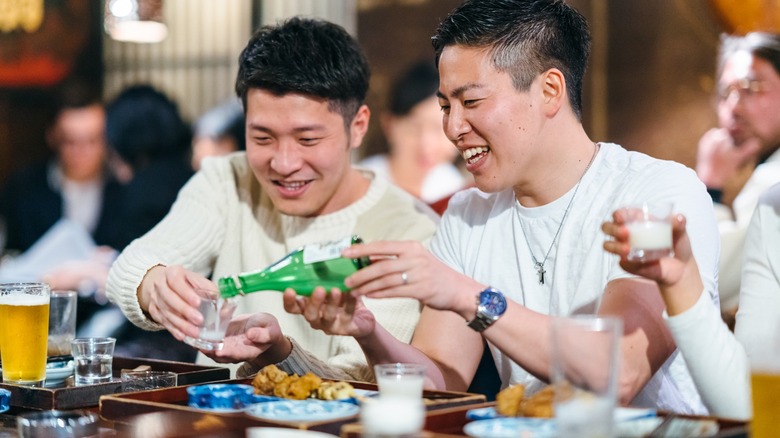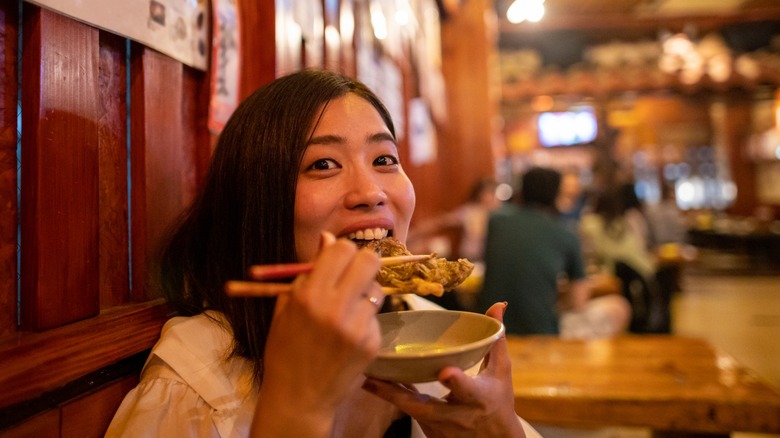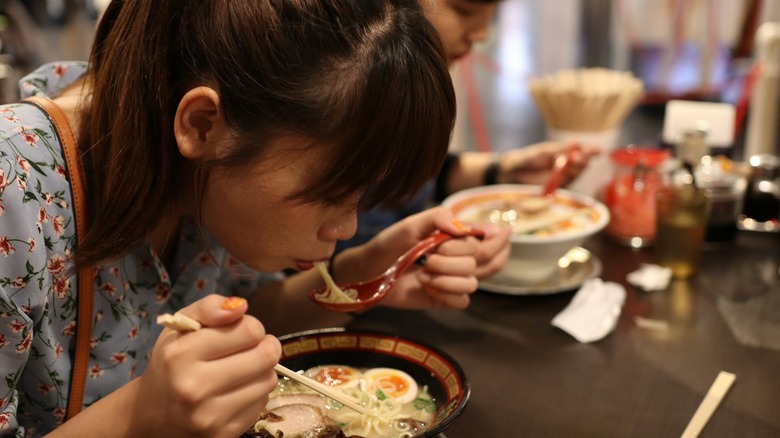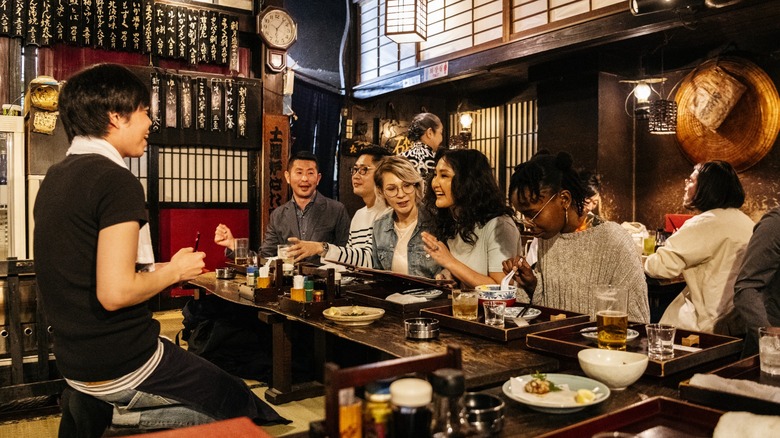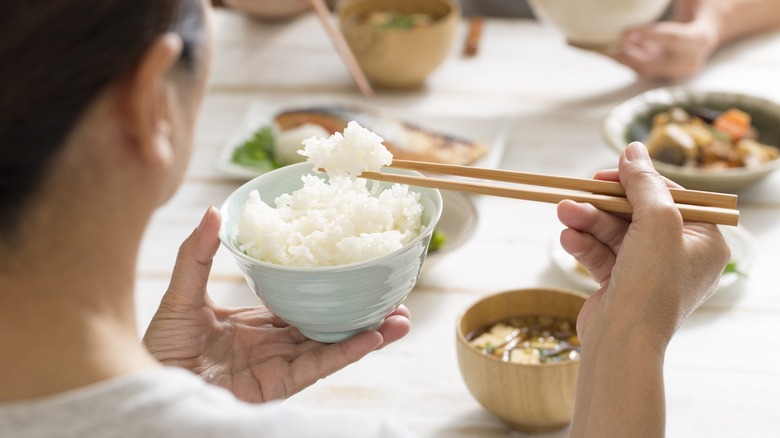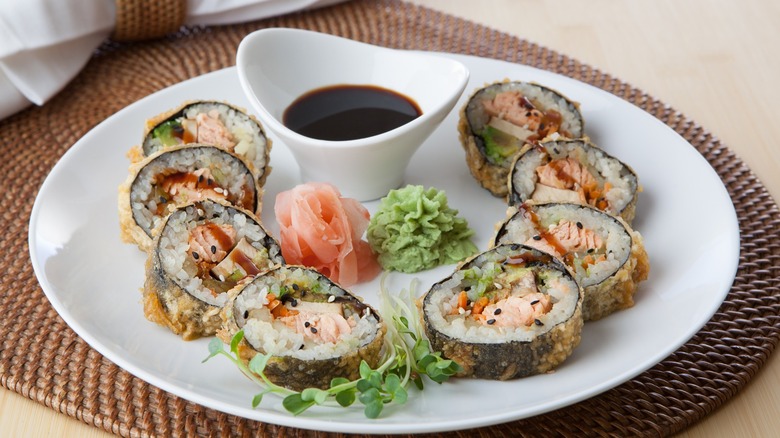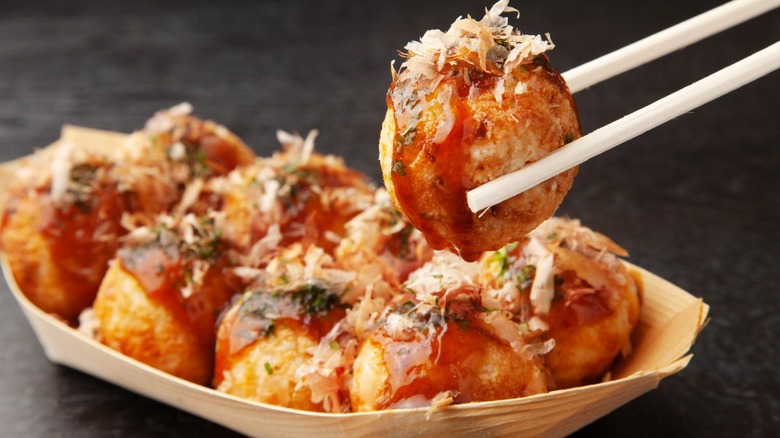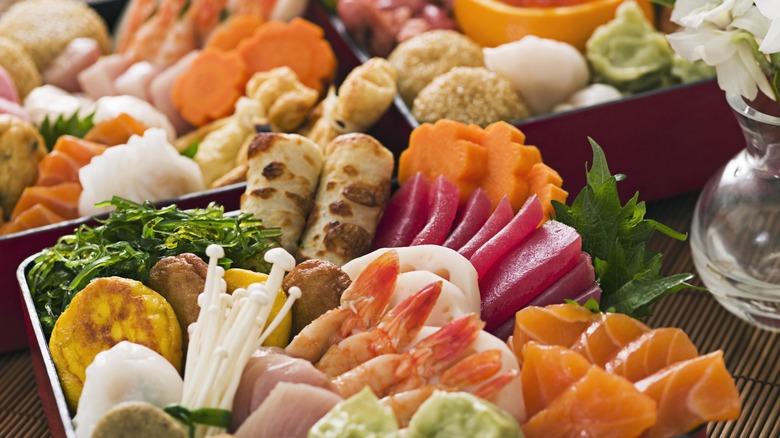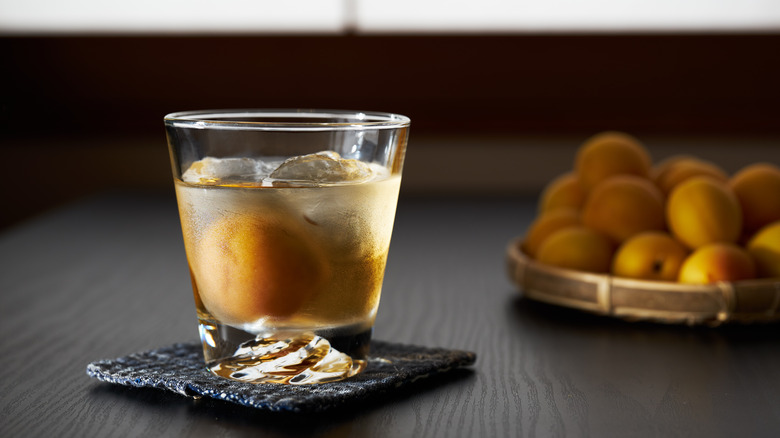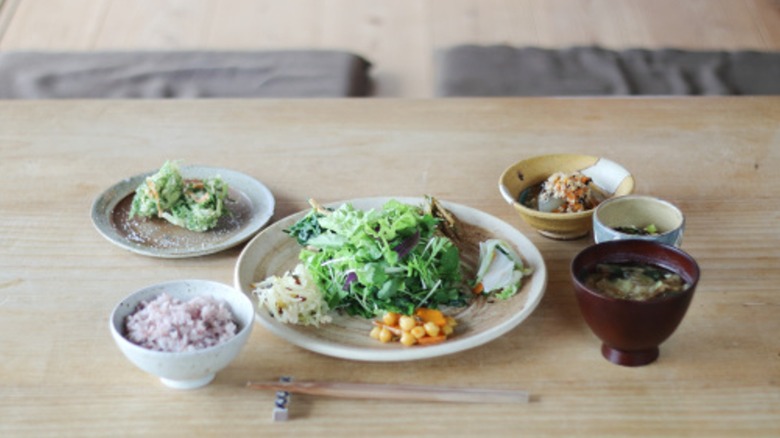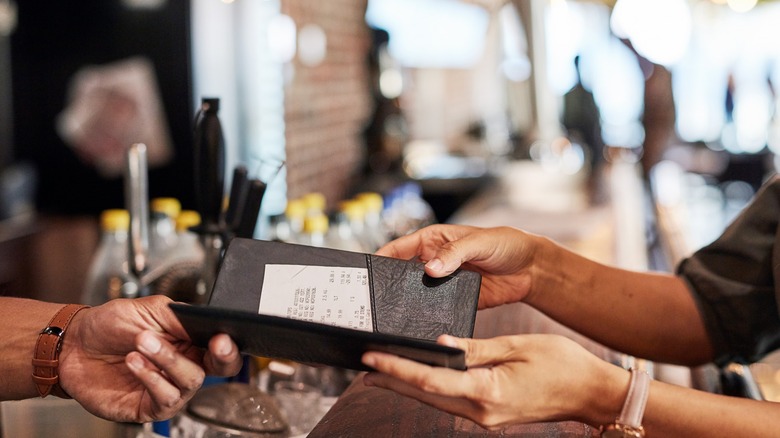14 Mistakes You're Making When Eating At A Japanese Restaurant
If you've been to your local hibachi place or all-you-can-eat sushi stop, you may think that you've got a pretty good handle on manners and Japanese dining etiquette. You might be shocked to learn that you might be wrong, however. Many unspoken rules reflect the culture's deep appreciation for food and craftsmanship, as well as the importance of respect, all rooted in hundreds of years of tradition.
But before you get too worried about it, read on to learn the most basic ways to act while enjoying the culture's incredible foods. Don't get too caught up in trying to be a perfect guest. You'll likely find that if your hosts understand that you're trying to be respectful, they will forgive many mistakes — enjoy your food rather than not eating because you're too intimidated. The Japanese place a lot of importance on the idea of making everyone feel comfortable; if your tablemates sense that you're just doing your best, they will respond in kind and encourage you to keep enjoying your meal.
Missing important etiquette from the beginning
While many Japanese restaurants in North America don't abide by these rules, you never know when something might catch you off guard. Keep in mind that Japanese culture takes into consideration both your comfort, as well as the comfort of others. Yes, this means that you need to think about how your table-side errors or noises might just discomfit others.
This encompasses seating arrangements, your footwear, and even that delightful towel that you might be tempted to press against your face. The best seat (kamiza) is reserved for the eldest or most honored guest. This generally means the head of the table or the seat farthest from the door. If the restaurant requires you to remove your shoes, do so without complaint and pop on a pair of the on-hand slippers. Be aware that you may even be required to wear a separate pair of slippers in the bathroom — this is normal Japanese etiquette, and you'll be supplied with everything you need. Finally, if you're lucky, you'll be given an "oshibori" (a hospitality towel) that is either hot or cold and is used to cleanse your hands before eating. Meant for hands only, wiping the oshibori over your face or neck is disrespectful, no matter how tempting it might be.
Not understanding some of the words you might hear
There are all sorts of Japanese restaurants, from sushi to hibachi to izakaya, and you might encounter a few particular words during your time visiting them. We don't necessarily mean all the delicacies listed on the menu, however. What we're talking about are the general greetings and polite talk that you might hear during your meal.
At a sushi restaurant, you'll often be greeted by a delightful chorus of "irasshaimase" (welcome) from the chefs, which is a standard greeting. If you're feeling particularly international, feel free to reply with "ojamashimasu" (thank you for having me). Something else you might want to practice is the humble word "itadakimasu" which simply shows appreciation for the food and everyone that had a hand in preparing it, from the farmer to the chef to your server. Finally, once you've finished your meal, "gochisousama" is the proper way to say thank you. This is a way to thank the chef for cooking for you and shows that you were pleased with the food and service.
Misusing chopsticks
One of the most fraught parts of Japanese table etiquette is the use of chopsticks — hashi if you're working on your language skills. They have a lot of cultural significance and specific rules for use beyond not pointing, scratching, or tapping. Don't use them separately for any reason, like stabbing chunks of food or foraging around for all the best bits. Just as bad, don't push them together and use them to shovel food into your gaping maw.
If there's a chopstick rest, please use it — don't lay them across your bowl or flat on the table; if no rest is available, use the left-hand edge of your tableware to rest the tips of your chopsticks. In casual restaurants that supply disposable ones, fold the wrapper into a small shape and use that as a rest. As well, chopsticks should never actually go into your mouth. This means you can't lick them clean or rinse them in your soup; if you need to clean your chopsticks, use a paper napkin. Finally, when finished eating, slide them back into the paper wrapper to signal you're done. In a more formal environment, lay them horizontally rather than vertically (pointing the tips toward your dining companions is frowned upon), with the tips pointing to the left.
Not serving others first
Always make sure that your elders and the special guests are served first, then work your way down to the youngest guests, and finally yourself. Read on for the rules about when it's okay to start eating without waiting for everyone else, but for now, let's talk about alcoholic beverages.
Japanese culture has a few rules around drinking. If you're simply out with your friends, you might find things a bit more relaxed but keep these notes in mind, nevertheless. First, never serve yourself a drink. In Japan, the first round, in particular, is served to everyone at the same time, and no one sips until kanpai is uttered and glasses clinked. When clinking your glass, try to ensure that yours is lower than your older or more superior business partners as a sign of respect. To continue drinking, waiting for others to refill your glass is still good manners. Refill the glasses of those around you when the time comes, and they'll repay the favor by replenishing yours. If you find your glass is still full when someone wants to replenish yours, take a quick sip so they can serve you.
Waiting for everyone else to start
In Japan, you will often be encouraged to start eating even before everyone else has been served. Waiting for everyone to be served means that your food will cool down and be less tasty than when it was brought to you. If you are still waiting, it's customary to encourage your tablemates to start without you, saying "meshiagarikudasai" (please eat) or "atsui uchi ni tabete" (eat it while it's hot). Food is brought out as soon as it's ready, rather than waiting to serve everyone at once. It's very common for large groups to be served at all different times, depending on what was ordered. This is simply so that the food is eaten at its best.
At a family dinner, most items will be brought out in large, communal dishes meant for sharing. However, if you're eating in a restaurant, you may have all ordered separate dishes. In this case, those served first are encouraged to go ahead. As mentioned previously, remember to say thank you before starting your meal, especially if you're being spurred on to begin eating before others. Otherwise, don't fret about starting before other people at your table, but if you're at a business dinner, make sure that your superior has given their consent.
Not slurping certain items
While frowned upon stateside, there are certain occasions when slurping your noodles is perfectly acceptable in Japan. Dishes like ramen and soba are made with great care and are historically significant to the culture, and because of this, they have a few traditions surrounding them. Generally speaking, all restaurants in Japan will make the food as it's ordered to serve the freshest and hottest items possible. You'll receive a steaming hot bowl of noodles and broth and be expected to dig in right away.
By inhaling as you eat your noodles, you're simultaneously cooling the broth and also getting more of the broth in your mouth. The act of inhaling air also helps to bring out the most flavor from your food, giving you a fuller experience and a better appreciation for the dish. Finally, you should do your best to slurp up the entire noodle without biting into them. Biting them allows food to fall back into your dish, which is seen as rude. So, go give it your best shot and inhale, slurping up the whole mouthful at once.
Being afraid to call your waiter
If you find yourself needing to get your waiter's attention in a Japanese restaurant, would you know what to do? Many people assume they should just sit and wait for their server to come to them, as we do in America. Instead, you'll need to take the lead and actually call your server to your table. Calling out "sumimasen" (excuse me) is usually enough to get their attention. In a more formal dining environment, sometimes just a hand signal is enough, but in a crowded izakaya or ramen shop, you might have to use your voice.
This may seem rude to North Americans (but remember, you're not snapping your fingers and speaking abruptly) while it's common practice in Japan. Most places in Japan are busy, and the waitstaff are doing many things at once. By calling out to them when needed, you're letting them focus on the other parts of their job instead of hovering over you.
Catching falling food with your hand
You may have been taught that lifting your bowl to your mouth is bad manners, but in Japan, the opposite is true. You'll notice that a Japanese meal usually consists of a number of small plates and bowls rather than one large plate. This is to facilitate lifting your serving of rice, making it easier to eat with chopsticks without making a mess. It is considered rude to use your hand to catch food that falls from your mouth. Instead, you should lift your bowl closer to eat without spilling.
For something like soup, it is permissible to use chopsticks for the solid pieces and then sip the broth directly from the bowl. You're also always welcome to use a spoon, especially for something like curry rice. A good rule of thumb for what you can and can't lift to your mouth is this — anything that fits in the palm of your hand is made to be lifted, as well as donburi bowls (a rice dish served with stewed meat). Don't lift tempura, sushi plates, or anything communal or large. It is permissible, even encouraged that you lift soup containing noodles in order to avoid splashing everyone around you while you slurp up the delicious, soupy noodles.
Mixing wasabi into your soy sauce
One of the most popular Japanese cuisines here, sushi has rules of its own. To begin, understand the role of wasabi and soy sauce and when to use them. Every bite should already have balanced flavors and textures that shouldn't need the addition of either condiment. Nigiri can be dipped into soy sauce (it might already have a dab of wasabi under the fish), but it must be turned upside down first, dipping the fish side (rice will absorb too much sauce and overpower it). Try the sushi as intended to savor the freshness and balance, foregoing the messy wasabi and soy concoction. Sushi chefs practice for years, learning the best combinations to highlight the ingredients as well as their skills.
And you're not being uncouth if you eat sushi with your hands. Pick up a piece and eat it in one bite, if possible, without separating the ingredients or letting it sit too long. Another mistake is adding slices of that delicious, pink pickled ginger (called gari) to our dynamite rolls or uramaki. While it's incredibly good, it is meant to be used as a palate cleanser rather than a condiment. After you've had a piece of nigiri made with particularly tasty and fatty tuna, eat a sliver of gari to prepare your tastebuds for something lighter.
Placing half-eaten food back onto your plate
Using chopsticks means that much of the food eaten in Japan must be served already cut into bite-sized portions. It is very rare to see a knife on the table; for that reason, everything must be ready to eat or have a soft texture that can be separated with a spoon. You shouldn't have much problem fitting each bite into your mouth without having to return pieces to your plate. If you come across a piece that is relatively large, it's more acceptable to eat it while covering your hand with your mouth instead of biting it in half.
Obviously, this isn't always the case, and some things will need to be eaten in a few bites, such as onigiri. These triangular-shaped rice balls are a popular on-the-go snack and are meant to be eaten out of hand, much like an American sandwich. In the case of something like this, you can simply unwrap it and carefully eat it with small bites. Holding the onigiri with two hands will help to keep it in one piece so that you're not dropping rice everywhere, too.
Wasting food
Unlike other countries, in Japan, leaving food on your plate is seen as rude. You should never take more than you think you can eat and always finish what you've been given. This also extends to condiments, especially soy sauce. Soy sauce is culturally significant, and its production is held in much higher regard than it is in North America. It is something to be savored, and as such, has certain etiquette rules.
The notion of food waste is something to be aware of, as well. Taking too much and leaving it uneaten looks gluttonous, as well as showing disregard for your fellow diners. Don't overorder and assume that you can take it home in a doggy bag, too, as this is only sometimes an option. However, if there's something in the dish that you really can't stand or if you're actually allergic to it, your host will generally be forgiving of this if you make an effort to eat everything else. While it's frowned upon to ask for a lot of modifications to your meal, as food is carefully crafted to bring out the best qualities of each ingredient, you can often request it in the case of allergies or religious prohibitions.
Assuming that sake is the only drink on offer
While sake is a category that rightly deserves to be explored, you should be aware that Japan offers a number of other tasty beverages as well. Sake is a rice wine fermented with koji — the rice mold responsible for mirin, soy sauce, miso, and rice vinegar, that has become ubiquitous with Japanese alcohol. In recent years, distillers have started turning out some impressive whiskeys, such as Suntori and Nikki. Be warned, though — these can be hard to find and occasionally are very expensive. However, if you're able to pick up a bottle of something attainably priced, we highly recommend that you try this version of a highball.
Other libations include ume plum wine, shochu, beer, and an emerging market of canned mixed drinks. As well, Japan has also started producing wine domestically rather than importing it, so you may want to give those a go, if given the chance. If you do happen to overindulge, don't be too worried about it. Remain respectful and subdued; slow down a little and you should be fine.
Piling all your plates up when you're finished
In North America, we have a penchant for piling up all of our empty dishes, assuming that we're making things easier for the serving staff. However, in Japan, this isn't the way to go. Returning all of your plates, bowls, chopsticks, and everything else back to their original spot is the proper way to finish a Japanese meal. Return your chopsticks to their rest, replace lids, and put your empty rice and soup bowls where you found them.
To begin, there is a pretty strict order to the way a Japanese table is laid out, with specific food positioned in specific places. For example, your soup will appear on your front right, while your rice dish will be next to that on the front left. The main dish is placed at the back left with a salad or a simmered side dish next to it, and the middle spot is used for a side dish of vegetables. Returning everything to its original position is preferable to stack them, as it shows respect for the importance of tradition, as well as the idea that piling dishes on top of each other is seen as messy and possibly spreads germs.
Not letting your host pay
A final piece of cultural knowledge — typically in Japan, the person who makes the invite is the one who pays. This can seem hard to accept to those of us who are used to splitting the tab. But here, it's disrespectful to argue about who is paying. If you make a fuss about being treated to dinner, you're making it seem like your host can't afford it or is too cheap to pay. That's a big insult and can result in a strained relationship.
Having said that, there is nothing wrong with bringing your host a gift to thank them for their thoughtfulness and the invitation. This is a gracious way to recognize the culture of giving and receiving, as well as showing your appreciation for their hospitality.
